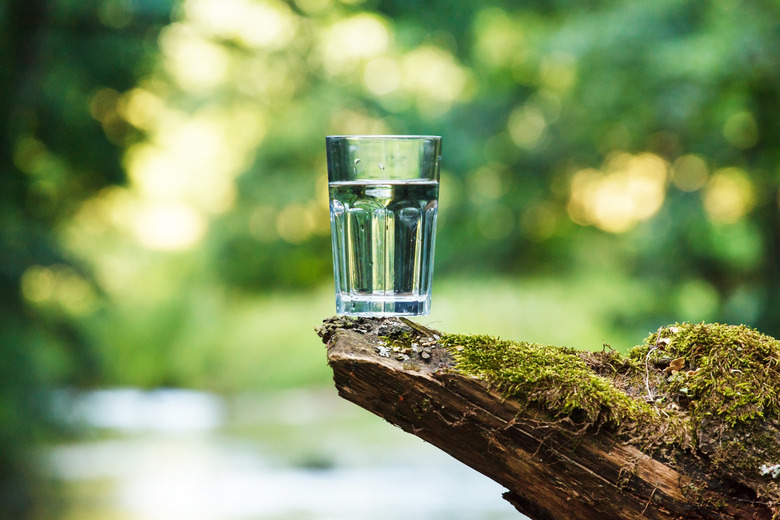'Down To Earth' Teaches Tips For Finding The Best Bottled Water
If you're one of those people who have always believed water has a taste, you were definitely on to something. It's not just water. It can be sweet, salty, smooth, fruity, complex, bitter and even metallic.
The Prettiest Waters Around the World
In the second episode of Zac Efron's new Netflix feel-good show "Down to Earth," he and his co-host Darin Olien are joined by actress Anna Kendrick in Los Angeles for a water tasting. It's presented just like a wine tasting by water sommelier Martin Riese — and yes, a water sommelier is a real title.
Riese, who is skilled at detecting water quality and taste, has them try a number of different waters from different places in the world and of different qualities. They talk at length about something called TDS, which stands for "total dissolved solids." On his website, Riese explains that TDS "measures the mineral composition of any given water, which results in creating its own specific flavor profile and character. TDS levels determine how much sodium, magnesium, calcium and other minerals are present."
According to Riese, TDS can determine how your water of choice will pair with your food of choice. On his "water menus," TDS levels begin at under 10 milligrams on the low end and go all the way to 3,000 milligrams on the high end. The higher the TDS, the more minerals and taste the water will have.
In the "Down to Earth" episode, one water from Australia had a TDS of 1,300 and Riese described it as "the olive oil of water."
Taking a cue from Efron, it only makes sense that we figure out not just how to make sure you're properly hydrated but also how to understand what we're drinking. We may not all have access to a certified water sommelier, but many Americans do have access to various kinds of water. To help you get started, we've outlined the difference between spring versus purified and which bottled waters have high and low levels of naturally occurring TDS.
Spring water
Spring water has a noticeably crisper flavor than purified or mineral waters because nothing has been added to it — but not all spring bottled water is the same. The U.S. Food and Drug Administration actually sets strict regulations for spring water, which has to be "derived from an underground formation from which water flows naturally to the surface." For it to be authentic spring water, it has to be collected at the spring itself or through a borehole. However, if an external force (such as a pump) is used to move the water to the surface, it can still qualify as spring water if the quality and composition stay the same.
Evian is an example of spring water, and during its at least 15-year journey through the French Alps, "it picks up calcium and magnesium producing a slightly bitter, unique taste that you will either love or hate," according to Riese's website. Evian has a TDS of 340 milligrams, while bottled spring water by Niagara Bottling, LLC, which produces private-label bottled water for a number of companies and grocery stores including Walmart, Safeway Inc., Costco and Jewel-Osco, contains 102 milligrams of TDS. Poland Spring brand spring water, on the other hand, contains between 32-76 milligrams of TDS, which is relatively low.
Purified water
While spring water is made in nature, purified water is essentially made in a factory. It's municipal water (also known as tap) that has been treated before being bottled. It's low in both minerals and electrolytes, which means it's not replenishing your body as well. According to the FDA, bottled water that has been treated by distillation or reverse osmosis usually meets standards that allow it to be labeled as purified water. Examples of purified water include Dasani, Aquafina and SmartWater.
Mineral water
Mineral water comes from natural springs but must contain at least 250 parts per million of TDS. Per FDA regulations, minerals and trace elements must come from the source of the underground water and cannot be added later. This differentiates it from bottled waters that have been "enhanced with minerals." For example, Niagara Bottling's "purified water with minerals added for taste" has only 32 milligrams of TDS. Examples of mineral waters are Topo Chico and Perrier.
Artesian water
Artesian water comes from an underground layer of rock or sand that contains water. Groundwater in what's called "aquifers" between layers of poorly permeable rock or clay may be confined under pressure. When this type of water is tapped by a well, the water rises above the top of the aquifer and flows from the well onto land for sourcing. Examples include Fiji Natural Artesian Water, which contains 224 milligrams of TDS.
The biggest lesson in all of this is that you should read bottled water labels before slurping on your H2O. If you're unsure if the bottled water you're drinking is up to par, you can look up water quality reports of any water brand or company, or contact them for a report if the TDS isn't listed on their website.
To have your own water tasting and determine your personal water preferences, you can buy different brands of water with different TDS levels and taste them side by side. Water experts suggest tasting them for the first time at room temperature instead of chilled to see how different they actually are. Drinking water is fundamental to staying healthy, but it can also be an enjoyable experience.
